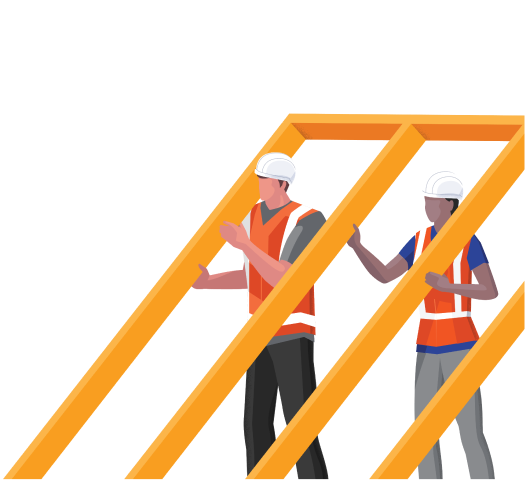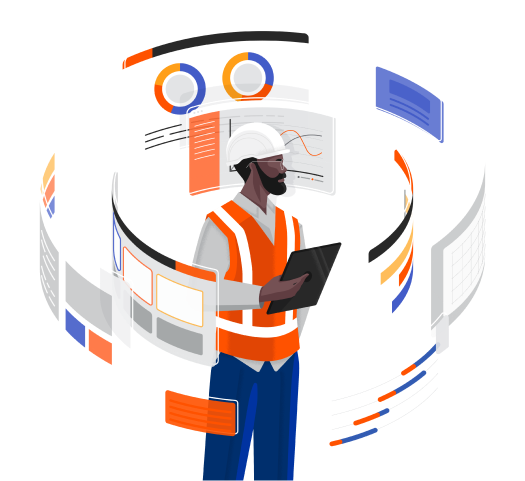— 9 min read
Estimating for Electrical Contractors: A Step-by-Step Guide
Last Updated Mar 4, 2024

In the world of electrical contracting, you have to estimate and submit bids in order to win projects and stay in business. This means bidding low enough to win against many competing electrical contractors, while high enough to cover all the project costs like labor, material, equipment, subcontractors, and overhead required to run your business. And, of course, enough profit to invest back in growing the business. In the steps below, we've outlined a proven electrical estimating system to help you get started.
Learn more: A contractor's guide to cost estimating
Contents
Table of contents
1. Bid the right jobs
The first step in the electrical estimating process is selecting the right type of work to bid. You should avoid bidding electrical projects where you have limited experience. Without historical data to draw from, you are more likely to make mistakes during the estimating process that could eat into profit margins during project execution. There’s a steep learning curve for electrical estimators and your field staff when taking on any new type of work that can eat into your profit.
2. Review the specs
Thoroughly review the specifications, including Division 01 general specifications in addition to Division 26. Pay close attention to contractor qualifications, payment terms, bonding capacity, insurance requirements, etc. to make sure you can meet the qualifications. Review the terms to ensure you can live with the legal language should you win the job.
When you’re finished with the general specifications, it’s time to move onto the Division 26 specifications. Make a note of the material grade, installation methodologies, and responsibilities of costs (who provides fire alarm, communications, etc.) Generally, the specs will determine the quality of materials while the drawings determine quantities.
It’s important to highlight anything out of the ordinary and make sure you include these items in your bid. I’ve seen many contractors take a black eye on an otherwise profitable project because they bid a less expensive material grade only to find during the project execution that it was significantly more expensive. If you intend to offer an alternate option, make sure you get approval first -- in writing -- because they will otherwise hold you to the specified material grades.
Learn more: Navigating the RFI process in construction
Make it easier to manage construction.

3. Review the drawings
Look over the drawings at a high level to get an idea of the full scope of work. You should review the architectural in addition to the electrical drawings to understand working heights and elevations that will affect labor costs, material pricing, and equipment requirements.
Once you have an understanding of the general construction (the bird's eye view of the project) it’s time to review the Division 26 drawings. Take note of any technical details that are depicted and watch for any discrepancies between the drawings and specifications and write this down.
4. Perform a quantity takeoff
If your estimating software can't handle electrical takeoffs, you may have a long night ahead of you. It's time to pull out your highlighters and scale master to begin the process of counting and measuring items depicted in the electrical drawings like light fixtures, receptacles, conduit runs, panels, and gear.
Start with one item (I recommend light fixtures) and count all items, sheet by sheet, keeping totals per sheet before moving to the next item. If you find something you missed earlier, immediately count it and adjust your previously noted quantity. Now total your quantities for each sheet and move to a quantity takeoff sheet. Note: Are you responsible for HVAC hookups or any low voltage?
5. Get current supplier pricing
One of the reasons I suggest getting your lighting counts first is to expedite the process of receiving a quote. These items are generally quoted independently of the rest of your materials.
Instead of worrying about the specifics on the light fixtures, note the designations used to identify the fixtures on the plans (i.e. A1, B1, C1, etc.). The lighting firm will reference the lighting schedule and look up the item details and provide a lump sum quote. It’s in your best interest to build a relationship with local lighting firms to ensure you’re getting competitive pricing in a timely manner.
6. Create your estimate
Just like with takeoffs, if you don't have an estimating program that can automate this process, there's a lot of manual effort at this stage (and potential for human error).
Now that you have the quantities laid out, you’ll need to determine the unit cost for each item. To accomplish this, you need to determine the material and labor costs associated with each task and extend those out by the task quantity.
Determining the material cost is simple -- a quick call to your supplier or pricing service can give you this data -- but the labor cost requires that you know how long it takes to install the material. This requires past production history and experience. (If you do not have past production history and limited field experience, I suggest purchasing NECA’s Manual of Labor Units to use as a guide.)
Multiply the labor unit by the burdened labor cost to determine the labor cost for the task. Now you’ll want to summarize the total material cost and total labor hours for all the items and you’ll multiply the labor hours by your fully burdened hourly labor cost to get your total labor cost for the task.
Add these two numbers together to determine your total direct costs for the project and the basis for your estimate. Keep in mind: You’ll need to add line items for any other direct costs required for the installation, like equipment rentals or subcontractors.
7. Add overhead & profit
Now that we have our estimated job cost -- i.e. direct costs -- we need to add profit and overhead to those costs to arrive at our sales price. While profit is pretty self-explanatory, many contractors confuse overhead. I've spoken with many small contractors that try to convince me they don't have overhead and shouldn't charge for it. This is not correct. Every electrical contractor has overhead, and it's in your best interest to figure out the amount you need to bill to each job in order to keep the lights on.
Overhead is the total of all other indirect expenses that are required to run your business, including your office lease, estimating, sales, marketing, bookkeepers, and other expenses that must be paid to keep your business operating smoothly.
Like profit, overhead is a percentage that you add to the project costs to land at your sales price.
8. Build your proposal
Now that we have our sales price, we need to create a proposal that details what is included in our bid in clear and concise terms. I always recommend using similar language to what was used in the project specifications and drawings. This makes it easier for the general contractor to level the bids, and ensure you haven't omitted anything from your estimate. He needs to know you can trust your price.
Generally speaking, electrical contractors provide lump sum bids. This means you provide a fixed fee to cover everything outlined in your bid. This is where it’s important to clarify anything that you’ve included or excluded to avoid any confusion once the project is awarded.
9. Double check takeoff quantities & estimate
It’s always a good idea to get a second set of eyes from your estimating team to review your work prior to submitting your bid to ensure you haven't missed anything. This review should involve a counterpart taking off the project’s major systems and ensuring that nothing was missed during the original takeoff.
I suggest keeping a bid log (a simple excel spreadsheet) that shows recent and successfully completed projects by type and size with the price-per-square-foot listed for reference. While you should never bid projects this way, you can compare a previously completed project against your current project to see if there is a large variance in price. If there is a big delta, you need to figure out why. Note: You can use this log to help with preliminary budget numbers.
Stay Ahead & Leave Risk Behind
Manage, baseline, and improve your quality and safety program from your desktop and mobile devices.

10. Submit the bid
Once you’ve double checked your work, it’s time to submit your bid. Today, everyone submits bids electronically either through the bid site that they received the bid or via email. We suggest that you read the Division 01 specifications again: Look for any bid instructions and follow them to the letter.
11. Review the results
In the beginning, it can be tough to determine where you’re in the mix compared to other electrical contractors bidding the same work. Remember, General Contractors like to go with numbers from vendors they trust. They often value years of experience working together more than a low number. As a result, it might take a couple of bids to gain a General Contractor's trust.
When you lose a project, it’s always a good idea to ask the General Contractor how your bid stacked up against the competition. Sometimes they’ll send you the bid tabs with your competitors' numbers. Other times they’ll tell you that you were too high or too low for comfort.
Unless it’s a public bid, they’re not required to provide this information. But if you ask in a respectful manner you will likely receive feedback that will help you make adjustments on future bids. Note: It’s a good idea to request bid tabs on awarded projects as well to see if you’re leaving money on the table by bidding too low.
How to estimate electrical more accurately & easily
If you’re thinking that estimating seems like a lot of work, you’re right. Electrical estimating requires a serious time commitment -- and this goes up significantly if you do not have an electrical estimating system in place. Electrical estimating software provides you with an easier way to get your work done using a prebuilt system and methodology.
Good electrical estimating software gives you on screen takeoff, estimating, and quoting all in a single package with features like auto-count, a full electrical labor and material database, and a way to track your bids. If you’re new to electrical estimating, this can provide a framework to get you started. In my experience, electrical contractors using software see a 2-3x increase in speed over manually estimating projects with paper plans and excel. It's often less expensive than the cost of printing out plans, and much less prone to human error.
Categories:
Tags:
Written by
Chris Lee
14 articles
Chris is currently Director, Solutions Engineering at Procore. In 2015 he co-founded Esticom, a cloud-based takeoff and estimating application acquired by Procore in 2020. In a past life, he owned and operated a low voltage contracting firm based in Austin, Texas.
View profileWin More Work
Get discovered for relevant work on the Procore Construction Network.

Explore more helpful resources

Successfully Navigating Construction Lien Waivers
Getting paid can be one of the greatest challenges in construction and has often been the detriment of construction projects. To combat this challenge, issuing lien waivers has become standard...

Construction Administration: Keeping Projects on Track While Mitigating Risk
Construction administration is a term not all general contractors will be familiar with — it’s a catchall that includes multiple roles that are together responsible for contractual and administrative aspects...

Construction Drawings: Picturing Project Success
Every construction project — whether it be a kitchen renovation or a new highway overpass — relies on a set of comprehensive drawings to communicate what should be constructed. For...

Construction Teamwork: Build a Solid Foundation With the Right Team
Construction is an industry of collaboration — no one person completes any job on their own. It could easily be argued that the most important skill for anyone in this...
